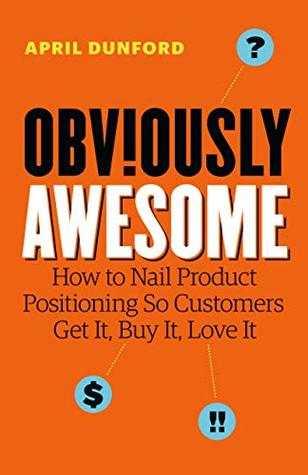Explore the World's Best Ideas
Join today and uncover 100+ curated journeys from 50+ topics. Unlock access to our mobile app with extensive features.
The importance of positioning
Positioning is intentionally defining how you are the best at something that a defined market cares about. Customers need to quickly understand your product, why it's unique and why it is important to them.
Positioning is vital to every tactic we use, every campaign we launch, every bit of content we create, and every sales pitch we make. If we fail at positioning, we fail at marketing and sales, and the entire business is at risk of dying.
58
314 reads
The signs of weak positioning
- Your current customers love you, but new prospects don’t understand what you’re selling.
- Your company has long sales cycles and low close rates, and you’re losing out to the competition.
- You have high customer churn.
- You’re under price pressure.
55
282 reads
Aspects of great positioning
Most products are exceptional when we understand them within their best frame of reference.
Great positioning considers all these aspects:
- The customer’s point of view on the problem you solve and other ways of solving that problem.
- The ways you are uniquely distinct from those alternatives and why that’s meaningful for customers.
- The characteristics of a potential customer that values what you can uniquely deliver.
- The best market context for your product that makes your unique value obvious to those customers who are best suited to your product.
56
206 reads
The five (plus one) components of effective positioning
- Competitive alternatives. What would your customers do if your solution didn’t exist?
- Unique attributes. The features and capabilities that you have and the alternatives you lack.
- Value (and proof). The benefit that those features enable for customers.
- Target market characteristics. The characteristics of a group of buyers that lead them to care about the value you deliver.
- Market category. The market you describe yourself as being part of to help customers understand your value.
- Relevant trends. Trends that your target customers understand that can help make your product more relevant right now.
60
200 reads
The 10-step positioning process
- Understand the customers who love your product
- Form a positioning team
- Align your positioning vocabulary and let go of your positioning baggage.
- List your true competitive alternatives
- Isolate your unique attributes or features
- Map the attributes to value “themes”
- Determine who cares a lot
- Find a market frame of reference that puts our strengths at the centre and determine how to position in it
- Layer on a trend (but be careful)
- Capture your positioning so it can be shared.
66
175 reads
Understand the customers who love your product
Your best-fit customers hold the key to understanding what your product is.
Make a shortlist of your best customers. The best customers understood your product quickly and bought from you quickly. They referred you to other companies and acted as a reference for you.
56
160 reads
Form a positioning team
A positioning process works best when it’s a team effort from different functions within the company as they can bring a unique perspective to how customers perceive and experience the product.
Consider these outputs that all flow from positioning:
- Marketing: messaging, audience targeting and campaign development
- Sales and business development: target customer segmentation and account strategy
- Customer success: onboarding and account expansion strategy
- Product and development: roadmaps and prioritisation
57
140 reads
Align your positioning vocabulary and let go of your positioning baggage
We have to consciously set aside our old ways of thinking to consider possible new ways to think about a product. This can be done with a common positioning vocabulary.
Get the agreement from the team that the product may no longer be best positioned in the way it was created with a certain market and audience in mind.
56
129 reads
List your true competitive alternatives
Understanding the customer’s problem isn’t enough. It is also important to understand the alternatives you are compared to.
To do that, you need to understand who your real competitors are in the minds of customers. Grouping the alternatives can help the team move to the next step.
55
130 reads
Isolate and map your unique attributes or features
List all of your capabilities that the alternatives don't, then group them broadly into "themes". To group points of value, take the perspective of a customer.
For example, attributes like “works on any mobile device” or “works without an internet connection” provide value to customers who would like to use the solution in locations with intermittent or no Wi-Fi. You could group those attributes as “supports remote environments.”
57
125 reads
Determine who cares a lot
Once you have a good understanding of the value that your product delivers, then look at which customers really care about that value.
An actionable segmentation captures a list of easily identifiable characteristics of a person or company that make them really care about what you do.
The segment needs to be big enough that it’s possible to meet the goals of your business, and have important, specific, unmet needs that are common to the segment.
54
119 reads
Find a market frame of reference that puts your strengths at the centre
Pick a market frame of reference that makes your value evident to those who care about that value.
When you choose to position within a specific market, you give your prospects clues about what products they should compare you with.
Some ways to do this:
- Positioning to win an existing market by convincing customers that you are the best at delivering the solution.
- Positioning to win a subsegment of an existing market by targeting buyers who have different requirements that the current overall market leader is not meeting.
- Create a new market category that deserves to exist.
59
114 reads
Layer on a trend
You can use a current trend to your advantage if it helps to reinforce your position and the value of your offerings. Aligning with a trend can help make your offering look current and relevant.
- Only use trends when they have a clear link to your product.
- Use a trend if it is possible, but you can have a successful business without being trendy.
55
107 reads
Capture Your Positioning so It Can Be Shared
Once you have worked through your positioning, you need to share it across the organisation.
Positioning needs to have company buy-in so it can be used to inform branding, marketing campaigns, sales strategy, product decisions and customer-success strategy.
56
109 reads
Putting positioning into play
Once you have completed a positioning exercise, you can consider how to define a story of how a salesperson would pitch the product. The aim is that everyone agrees on how the positioning will translate into a pitch.
The team needs to agree on
- How to define the problem
- The current solutions
- The gap
- The key purchase criteria that a customer should have
Next, the marketing team will translate that into messaging to be used in marketing and sales materials, campaigns and the website.
57
120 reads
IDEAS CURATED BY
CURATOR'S NOTE
How to find your product’s “secret sauce” and then sell that to those who desire it.
“
Tanner Pratt's ideas are part of this journey:
Learn more about startup with this collection
How to create a productive environment
The importance of self-care in productivity
How to avoid distractions
Related collections
Different Perspectives Curated by Others from Obviously Awesome
Curious about different takes? Check out our book page to explore multiple unique summaries written by Deepstash curators:
20 ideas
Talha Mumtaz ✔️'s Key Ideas from Obviously Awesome
April Dunford
Discover Key Ideas from Books on Similar Topics
Read & Learn
20x Faster
without
deepstash
with
deepstash
with
deepstash
Personalized microlearning
—
100+ Learning Journeys
—
Access to 200,000+ ideas
—
Access to the mobile app
—
Unlimited idea saving
—
—
Unlimited history
—
—
Unlimited listening to ideas
—
—
Downloading & offline access
—
—
Supercharge your mind with one idea per day
Enter your email and spend 1 minute every day to learn something new.
I agree to receive email updates








